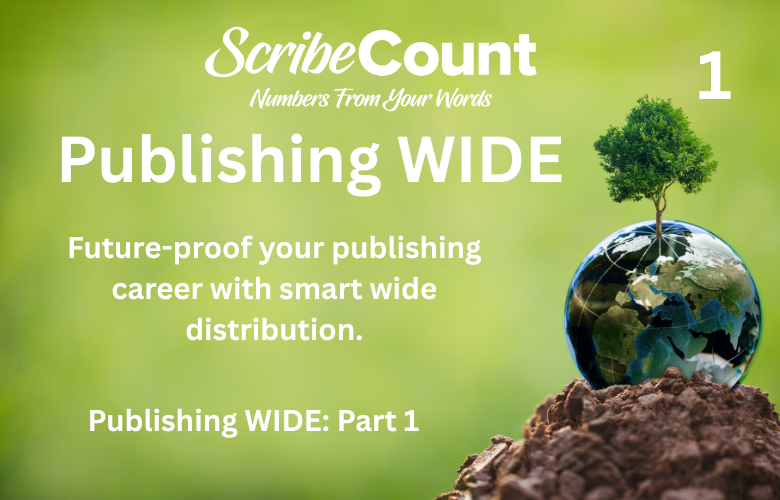What Is Publishing Wide"
80% of global ebook revenue is earned outside the Amazon ecosystem. That stat alone should catch the attention of every indie author focused on sustainable, long-term book sales. While Amazon offers undeniable reach, Publishing Wide is a business strategy that expands your distribution, audience, and income across the globe. In this article, I’ll explore what it means to publish wide, how to do it well, and which tools and platforms make the process smoother and more profitable. I’ll also show you how ScribeCount fits into the strategy.
A Quick History of Indie Publishing Beyond Amazon
Back in the early 2000s, when digital publishing first kicked off, the indie author scene was nothing like it is today. Amazon's Kindle Direct Publishing (KDP) gave authors a direct line to readers, and for a while, that was all anyone needed. It was revolutionary—a way to bypass traditional publishing gatekeepers and get books in front of a massive audience. But with the introduction of Kindle Unlimited (KU), Amazon started pushing exclusivity, pulling authors into a walled garden that restricted distribution.
Outside those walls, however, an entire world of readers waited. Publishing wide emerged as a counterbalance. It meant getting books into libraries, onto the shelves of Kobo Writing Life and Apple Books for Authors, and into the hands of readers in dozens of countries. Authors began to realize that Amazon was a great launchpad, but not the end-all-be-all of publishing. By skipping other platforms, they were leaving money—and readers—on the table.
Over time, wide publishing evolved from a tricky alternative into a legitimate, professional strategy. As tools, education, and author networks grew, more writers saw the power of leveraging every available platform—not just the one with the biggest name. Distributors, universal book links, and marketing tools for multiple storefronts became the new normal. The industry matured, and wide publishing became synonymous with career resilience and income diversification.
In parallel, companies like Draft2Digital and PublishDrive emerged to help simplify the wide process, aggregating storefronts and distribution outlets into a single dashboard. These innovations helped indie authors who were intimidated by the technical and logistical workload of wide distribution. Eventually, even print-on-demand services like IngramSpark and BookVault joined the effort to create a truly global, flexible publishing environment for indie authors.
The Wide Mindset: Thinking Like a Publisher
Here’s the truth: publishing wide isn’t about checking more boxes on a dashboard. It’s about thinking like a publisher, not just an author. It means taking control of distribution, marketing, and metadata. It requires patience, a long-term perspective, and a willingness to step beyond the comfort zone of the Amazon bubble.
You’re no longer just a storyteller. You’re a business owner. You’re not chasing algorithms—you’re crafting strategies. Wide publishing demands a mindset shift: instead of short-term sales spikes, you’re focused on building a diversified revenue stream, a global audience, and a brand that isn't held hostage by any one retailer.
You also need to think in terms of assets. Your email list becomes your number one asset. Your books aren’t just products—they’re intellectual properties that can be monetized through multiple formats, languages, and platforms. This mindset helps authors create sustainable careers instead of short-term wins.
Wide authors don’t wait for readers to find them. They go where the readers are—on Kobo devices in Canada, in the Apple Books store in Australia, in Google Play in India. They consider pricing in different currencies. They understand territorial rights, ISBN ownership, and multiple formats. They plan launches with different timelines and strategies for each platform. Most importantly, they recognize the value of long-term discoverability over fleeting rank spikes.
This mindset shift also changes how you interpret success. On Amazon, success is often measured by page reads or rankings. But wide authors define success through ownership, audience growth, and geographic reach. You may sell fewer units per day at first, but those sales come from multiple sources, creating a more balanced income stream. Instead of putting all your eggs in one basket, you’re nurturing several baskets across different platforms, reader groups, and markets.
Wide authors prioritize newsletter swaps, direct reader contact, and promotional stacking across different storefronts. They schedule launches around platform-specific opportunities like Kobo promos or Apple’s feature rotations. They’re attuned to international holidays, multi-language options, and time zone differences. This kind of thinking requires organization, planning, and intentionality. But it pays off with a career that’s not only sustainable but scalable.
Another core piece of the wide mindset is ownership. Wide authors often purchase their own ISBNs through Bowker in the U.S. or Nielsen ISBN Store in the UK. They control their metadata, keywords, and categories across all platforms, not just Amazon. They build launch plans that focus on long-term visibility instead of a one-day bestseller tag. They use universal book links from services like Books2Read to direct readers to the store of their choice, not a monopolized funnel.
They also prepare for a slower start. Unlike KU authors who might see a surge of page reads during a launch, wide authors may build momentum gradually, gaining traction across multiple storefronts. They’re okay with this because their strategy isn’t just about what happens this week—it’s about where their business will be next year. Wide publishing is a marathon, not a sprint, and those who embrace the mindset tend to see longer lifespans for their books, more stable income, and more diverse reader engagement over time.
For anyone thinking about going wide, the best primer I can recommend is "Wide for the Win" by Mark Leslie Lefebvre and Erin Wright. Not only is it packed with advice, but the Wide for the Win Facebook group offers live case studies, tips from seasoned wide authors, and support for every step of the process. It's a goldmine of collective wisdom for anyone serious about mastering the wide game.

